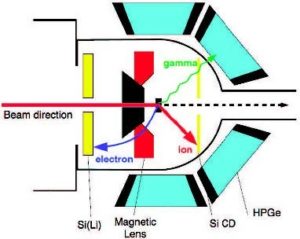- 01 Overview
- 02 How It Works
01 Overview
SPICE (Spectrometer for Internal Conversion Electrons) is an auxiliary detector used with the TIGRESS gamma ray spectrometer to capture a critical piece of nuclear transition that TIGRESS can’t measure: internal conversion electrons.
In TIGRESS experiments, most of the excited nuclei decay through the emission of gamma rays. But, for all the nuclear electromagnetic transitions that produce gamma rays, there’s a probability that they’ll occur through the emission of an internal conversion electron. In this case, rather than emitting a gamma ray, nuclear energy is transferred to an atomic electron, and the excited electron is ejected from the atomic system, an internal conversion electron.
Most importantly, one type of nuclear electromagnetic transition (E0 transitions) only occur through internal conversion electrons. This type of energetic conversion is invisible to TIGRESS, but in clear focus to SPICE.
Internal conversion electrons are particularly important for elucidating the quantum mechanics of nuclear shape co-existence close to the nuclear ground state mentioned in the TIGRESS section. If the first excited state is the shape-coexisting state, then the only allowed transition is the E0 transition. Quantum mechanically, there is mixing of the wave functions of these different shapes. The E0 transition is strongest when the shapes are very different and the wave functions are highly mixed
Thus, SPICE is essential for identifying the diversity and dynamics of nuclei particularly at and near closed shells where spherical and deformed shapes correspond to energetically competing configurations.
02 How It Works
The challenge in detecting internal conversion electrons produced in TIGRESS during in-beam spectroscopy is that they exist in a complex soup of other particles that includes photons, heavy ions and beta particles. To isolate the conversion electrons, SPICE uses a powerful magnet to U-turn the negatively charged internal conversion electrons towards an electron detector in front of the target (see image, below).

SPICE’s 10 cm diameter silicon detector is located 11.5 cm upstream of the target and, like a donut, has a one-centimeter hole in its the centre through which TIGRESS’ incoming heavy ion beam travels. SPICE’s powerful rare-earth magnet acts as a magnetic off ramp, collecting and diverting the electrons scattered from the target backwards to the detector.
The SPICE silicon detector is also sensitive to x-rays and gamma rays produced at the target, which would overwhelm the detector and obscure the conversion electron signals. SPICE includes a conical photon shield made of layers of tantalum steel, tin, and copper. This shield blocks photons produced at the target from view of the silicon, while the magnets steer conversion electrons around it.
SPICE was funded through a Canadian Foundation for Innovation grant through the University of Guelph. SPICE was designed and built at TRIUMF.
For more information about SPICE, please see here.